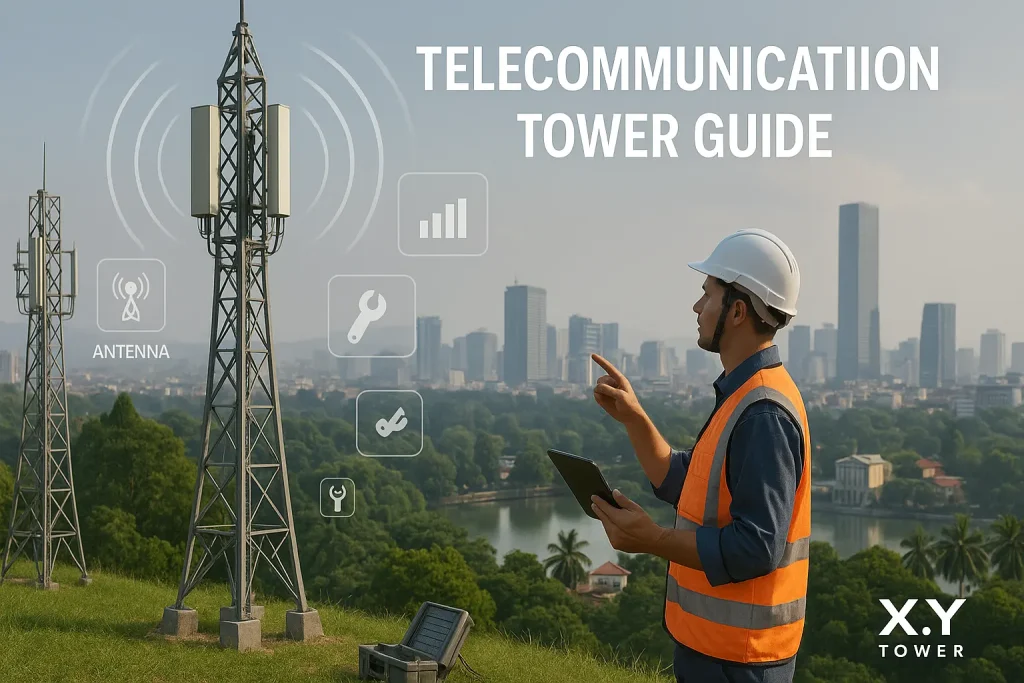Guide to Telecommunications Towers in Vietnam
2025-09-25
A telecommunications tower in Vietnam is a critical asset. It supports one of Southeast Asia's fastest-growing digital economies. Vietnam has a large and youthful population. This population is highly engaged with digital technology. This creates a powerful demand for reliable mobile connectivity. The country's long, S-shaped geography presents unique infrastructure challenges. It features mountainous regions, dense river deltas, and an extensive coastline. Infrastructure partners must deliver resilient and well-engineered tower solutions. A leading supplier understands these specific local conditions. They provide the essential foundation for robust 4G networks and the upcoming commercial launch of 5G.

Key Drivers for Tower Infrastructure in Vietnam
The demand for a telecommunications tower in Vietnam is fueled by strong and consistent growth drivers. A clear national strategy for digital transformation, coupled with intense consumer demand and a competitive mobile market, ensures continuous investment. These factors are propelling the expansion and modernization of the country's telecom network. Understanding these drivers is crucial for comprehending the opportunities within the Vietnamese tower sector. They explain the ongoing need for thousands of new cell sites.
The National Digital Transformation Program
The Vietnamese government has established a comprehensive National Digital Transformation Program. This program aims to develop the digital economy, digital society, and e-government. A core component of this strategy is ensuring universal access to high-speed internet. A telecommunications tower in Vietnam is a fundamental building block of this vision. It extends network coverage to rural and remote areas. This supports the government's goal of bringing digital services and opportunities to all citizens. This national policy is a powerful and long-term driver for infrastructure development.
Massive Growth in Mobile Data Consumption
The people of Vietnam are avid consumers of mobile data. The use of social media, video streaming, e-commerce, and digital payment platforms is widespread and growing rapidly. This mobile-first behavior creates an enormous demand for network capacity. Mobile network operators must constantly invest to prevent network congestion. They need to build more towers to densify their networks, especially in urban areas. This intense consumer demand is a primary and organic driver for every telecommunications tower in Vietnam.
The Push to Expand 4G and Launch 5G
While 4G coverage is extensive, there is a continuous push to improve its quality and reach. Operators are still working to bring reliable 4G service to every part of the country. This provides a steady demand for new tower builds. At the same time, Vietnam is preparing for the commercial launch of 5G. Operators have been conducting trials and are now planning their initial rollouts. The launch of 5G will require a significant new wave of investment. A telecommunications tower in Vietnam will need to be upgraded or newly built to support this next-generation technology.
Operational Challenges in the Vietnamese Market
Deploying a telecommunications tower in Vietnam involves overcoming a distinct set of operational challenges. The country's geography, climate, and regulatory environment create a complex landscape for infrastructure projects. A successful provider must have specialized expertise to manage these issues effectively. These challenges impact all phases of a project, from initial planning and engineering to construction and long-term maintenance. Addressing these hurdles is a key differentiator for leading infrastructure companies.
Engineering for a Typhoon-Prone Coastline
Vietnam has a long coastline that is highly vulnerable to typhoons and tropical storms. These weather events bring powerful winds and heavy rainfall, which can cause flooding. A telecommunications tower in Vietnam must be engineered to withstand these extreme conditions. This requires robust structural designs that can handle high wind loads. It also necessitates foundation designs that are resilient to flooding and soil saturation. This focus on climate resilience is a critical engineering requirement. This challenge is shared with other nations in the region, such as the market for a cell tower supplier Philippines.
Logistical Complexities of Diverse Geography
The geography of Vietnam presents significant logistical challenges. The mountainous northern region and the Central Highlands have difficult terrain and limited road access. The Mekong Delta in the south is a complex network of rivers and canals. Transporting heavy tower components and construction materials to sites in these areas requires careful planning. It often involves using a combination of trucks, boats, and specialized equipment. A top provider of a telecommunications tower in Vietnam must have a strong and adaptable logistics team.
Navigating the Regulatory and Permitting Process
The telecommunications sector in Vietnam is regulated by the Ministry of Information and Communications (MIC). Providers must adhere to its standards and regulations. In addition to national rules, there are also permitting processes at the provincial and local levels. Securing all the necessary approvals for a new tower can be a complex and lengthy process. An experienced provider of a telecommunications tower in Vietnam has a deep understanding of this administrative landscape. This expertise is vital for ensuring projects proceed without unnecessary delays.
Ensuring Network Security and Maintenance
Managing a geographically dispersed network of thousands of towers is a major operational task. Ensuring the security of these sites, particularly in remote areas, is important. Furthermore, the harsh climate can accelerate the wear and tear on equipment. This requires a robust and efficient maintenance program. A leading provider of a telecommunications tower in Vietnam uses a combination of scheduled maintenance and remote monitoring. This ensures the long-term reliability and performance of the network assets.
The Structure of the Vietnamese Tower Market
The market for a telecommunications tower in Vietnam has a unique structure. It has traditionally been dominated by towers owned directly by the mobile network operators. However, the trend towards infrastructure sharing and independent towercos is growing. Understanding this evolving market structure is essential for any company operating in the sector. It defines the key relationships between operators, suppliers, and infrastructure owners.
The Evolving Role of Tower Companies
Historically, the major mobile operators in Vietnam owned and managed their own tower portfolios. While this is still largely the case, the independent towerco model is gaining traction. Some operators have started to spin off their towers into separate infrastructure companies. This allows them to raise capital and focus on their core services. This gradual shift is creating new opportunities for a company that can supply or manage a telecommunications tower in Vietnam. This evolution is a key feature of the broader market for telecom towers Asia-Pacific.
The Competitive Landscape of MNOs
The mobile market in Vietnam is dominated by a few large, state-owned or state-affiliated operators. Viettel, Mobifone, and Vinaphone are the major players. This competitive landscape drives continuous investment in network quality and coverage. The network expansion and technology upgrade plans of these mobile network operators are the ultimate source of demand for new towers. A provider of a telecommunications tower in Vietnam must work closely with these MNOs to meet their specific requirements.
The Ecosystem of Suppliers and Contractors
A diverse ecosystem of companies supports the deployment of a telecommunications tower in Vietnam. This includes international firms that supply the advanced steel structures and high-tech components. They bring global quality standards and designs. These international suppliers typically work with a network of local Vietnamese construction and engineering contractors. These local partners provide the essential on-the-ground services, from civil works to installation. A successful project requires effective management of this entire supply chain. A similar ecosystem is found in the market for a communication tower Malaysia.
The Growing Trend of Infrastructure Sharing
There is a growing recognition in Vietnam of the benefits of infrastructure sharing. Sharing a single telecommunications tower in Vietnam among multiple operators is much more efficient. It reduces costs, speeds up deployment, and minimizes environmental impact. While the independent towerco model is still developing, the principle of sharing is being encouraged by regulators. This trend will shape the future of the market. It is a model that has proven highly successful in other markets, such as the one for a communication tower Indonesia. The business of cell tower leasing Indonesia provides a strong case study.
Technological Innovations and Future Trends
The technology associated with a telecommunications tower in Vietnam is rapidly advancing. Innovation is driven by the upcoming launch of 5G, the need for greater efficiency, and the challenges of the local environment. A leading provider must be an innovator. They need to offer solutions that are resilient, cost-effective, and ready for the future. These trends are defining the next generation of infrastructure in Vietnam.
Structural Preparations for Commercial 5G
The commercial launch of 5G is the most significant technological trend on the horizon. 5G will require a denser network and towers that can handle new antenna technologies. A telecommunications tower in Vietnam will need to be structurally capable of supporting the heavier loads of 5G equipment. Providers must offer 5G-ready designs for new builds. They also need to provide services to analyze and reinforce existing towers. This preparation is essential for a smooth and successful 5G rollout. This is a key focus in other advanced regional markets like the market for a communication tower Thailand.
The Need for Resilient Power Solutions
The reliability of the power grid can be a concern in some parts of Vietnam, especially in rural areas. The country is also prone to power outages during typhoons. This makes resilient power solutions for tower sites a critical need. There is a growing trend towards hybrid power systems. These systems combine battery storage with the grid and a backup generator. A leading provider of a telecommunications tower in Vietnam must have expertise in these power solutions. They are essential for ensuring high network uptime.
Diverse Tower Types for Different Environments
Vietnam's varied geography requires a range of different tower designs. The optimal design depends on the location, population density, and required equipment load. A comprehensive provider offers a portfolio of different structures for a telecommunications tower in Vietnam. This ensures the most efficient and cost-effective solution for each specific site. Key designs include:
- Self-Supporting Lattice Towers: The most common type, used for a wide range of applications.
- Monopoles: Sleek, single-pole designs with a small footprint, ideal for dense urban areas like Hanoi and Ho Chi Minh City.
- Guyed Masts: Cost-effective solutions for achieving significant height in rural areas.
- Rooftop Sites: Discreet installations on top of buildings to provide coverage in city centers.
The Adoption of Remote Monitoring and Digital Management
Managing a vast network of towers across a long country is a major operational challenge. Digital technology is providing new tools to make this more efficient. Remote monitoring systems allow operators to track the health of each telecommunications tower in Vietnam from a central location. They can monitor power systems, site security, and equipment performance. This technology reduces the need for physical site visits. It allows for a more proactive and predictive approach to maintenance.
Conclusion
The market for a telecommunications tower in Vietnam is poised for significant growth and transformation. It is driven by the country's powerful digital ambitions, massive data demand, and the imminent launch of 5G. The industry faces notable challenges, particularly related to its typhoon-prone climate and diverse geography. The market structure is gradually evolving towards greater infrastructure sharing. The future will be defined by the technological demands of 5G and the need for greater operational efficiency. A leading provider of a telecommunications tower in Vietnam must be an expert in resilient engineering, complex logistics, and regulatory navigation. They are essential partners in building the modern digital infrastructure that will power Vietnam's future.

Hey, I’m Chunjian Shu
"X.Y. Tower: Reliable, innovative solutions for high-quality towers and electrical equipment with professional service.
